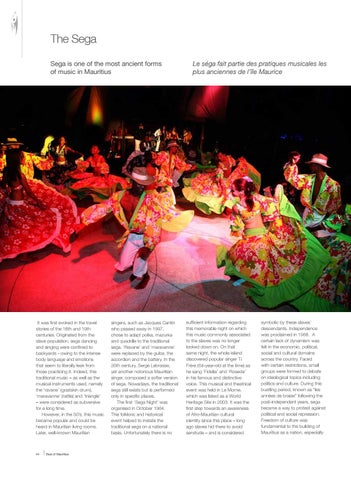The Sega Sega is one of the most ancient forms of music in Mauritius
It was first evoked in the travel stories of the 18th and 19th centuries. Originated from the slave population, sega dancing and singing were confined to backyards - owing to the intense body language and emotions that seem to literally leak from those practicing it. Indeed, this traditional music – as well as the musical instruments used, namely the ‘ravane’ (goatskin drum), ‘maravanne’ (rattle) and ‘triangle’ – were considered as subversive for a long time. However, in the 50’s, this music became popular and could be heard in Mauritian living rooms. Later, well-known Mauritian
44
Best of Mauritius
singers, such as Jacques Cantin who passed away in 1997, chose to adapt polka, mazurka and quadrille to the traditional sega. ‘Ravane’ and ‘maravanne’ were replaced by the guitar, the accordion and the battery. In the 20th century, Serge Lebrasse, yet another notorious Mauritian singer, composed a softer version of sega. Nowadays, the traditional sega still exists but is performed only in specific places. The first ‘Sega Night’ was organised in October 1964. This folkloric and historical event helped to instate the traditional sega on a national basis. Unfortunately there is no
Le séga fait partie des pratiques musicales les plus anciennes de l’île Maurice
sufficient information regarding this memorable night on which this music commonly associated to the slaves was no longer looked down on. On that same night, the whole island discovered popular singer Ti Frère (64-year-old at the time) as he sang ‘Fidelia’ and ‘Roseda’ in his famous and distinctive voice. This musical and theatrical event was held in Le Morne, which was listed as a World Heritage Site in 2003. It was the first step towards an awareness of Afro-Mauritian cultural identity since this place – long ago slaves hid there to avoid servitude – and is considered
symbolic by these slaves’ descendants. Independence was proclaimed in 1968. A certain lack of dynamism was felt in the economic, political, social and cultural domains across the country. Faced with certain restrictions, small groups were formed to debate on ideological topics including politics and culture. During this bustling period, known as “les années de braise” following the post-independent years, sega became a way to protest against political and social repression. Freedom of culture was fundamental to the building of Mauritius as a nation, especially
